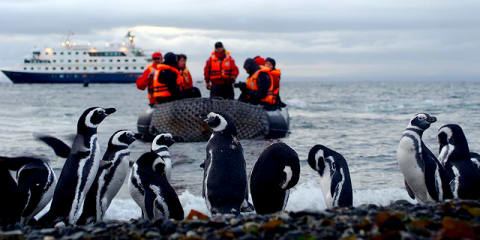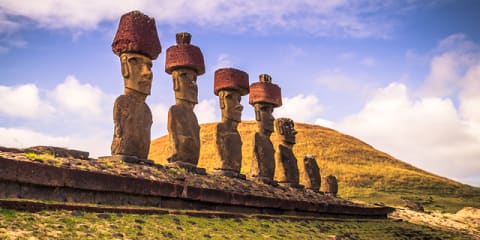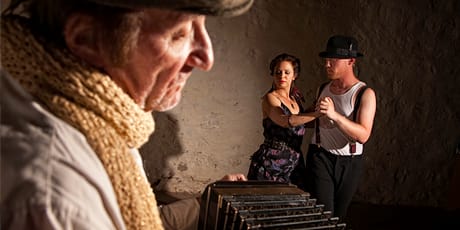 Argentina
Argentina
Skiers and snowboarders throng to Bariloche, a slice of Switzerland. Buenos Aires has been called the "Paris of the South," but its Italian fare rivals any served in Naples. Gaucho culture reigns supreme on the pampas, while the Iguazu Falls thunder from heights of 300 feet in a rush of rainbows and roaring water.
Tours & Packages
- Destinations: Argentina
- including closed packages


Trip Reviews & Photos
We love hearing your stories and seeing your photos! Check out our entire fan photo gallery and upload your photos.
Highlights
- Tango
Experience the irresistible style of tango dance in the place where it all started! Tango isn’t just a dance; it’s embedded into Argentinean life and social culture. There are numerous festivals and competitions celebrating tango dance, where professionals and novices come together and show off their moves (August is a popular month for festivals). Join a tango tour, where you will learn the history of the dance and how it’s evolved in modern times. Whether you watch a show while dining on authentic cuisine or join a tango lesson, there are endless ways to experience this passionate art form.
- Ushuaia
Small-town life meets a luxurious resort atmosphere in this picturesque city. The natural beauty of this town is truly remarkable – from its location on the pristine waters of the Beagle Channel with the majestic Martial Mountains rising in the distance – you’ll want to have your camera out as soon as you arrive! Ushuaia offers some truly one-of-a-kind experiences, like sailing the Beagle Channel to an island inhabited by adorable penguins. Sit back, relax, and enjoy the scenery as you embark on a railway journey through the mountain regions and into Tierra del Fuego National Park. Dubbed “The End of the World Train,” this steam engine transports passengers through remote areas of Ushuaia while offering incredible views of the wildlife and surrounding landscapes.
- Gaucho Culture
A man in a wide-brimmed hat, sitting atop a dark-colored horse, herding cattle in lush, green meadows. Shrouded in myth and mystery, the folklore of the Argentinean gaucho continues to captivate people. Emerging in the mid-18th century, gauchos were nomads who rode their horses from estancia (rural estates of the wealthy) to estancia in search of work. Their iconic wardrobe (including loose pants and a lasso) is as much tale as truth. Today, the number of traditional gauchos has dwindled, with the majority of remaining gauchos living in the Pampas. However, you can still enjoy the gauchos’ incredible display of horsemanship during a performance on an estancia.
- Buenos Aires
New adventures await around every corner of Argentina’s eclectic and energetic capital city. Experience the many forms of tango – from locals’ spontaneous gatherings on street corners to intense competitions under flashing stage lights. Snack on freshly-baked empanadas as you stroll through San Telmo Market on a lazy Sunday afternoon. Bask in the warm sunshine as you wander around the city, admiring the Neoclassical and Art Deco architecture of buildings. See brightly-colored houses in the La Boca neighborhood, and be awestruck by the extravagant designs in Recoleta Cemetery. And don’t forget to stop in the city’s famous square, Plaza de Mayo, an integral part of Argentina’s political history for more than 130 years. The Casa Rosada stands out the most, thanks to its pink color and stately design, but the plaza also includes a bank, a cathedral, and other monuments.
Fast Facts
Already booked on one of our packages to Argentina? See everything you need to know before you go.
| Overview | Capital: Buenos Aires |
| Entry requirements | Please see our Entry Requirements page. |
| Staying Healthy | Malaria According to the CDC, there are no malaria areas in Argentina. CDC Malaria guidance: Argentina Yellow Fever The CDC recommends Yellow Fever vaccine for all travelers who will visit Yellow Fever Endemic areas of Argentina. Ask your physician for more information. CDC Guidance by country: Argentina |
| Weather | In Argentina, the seasons are opposite what they are in the Northern Hemisphere. Generally, during the summer months of October to April are the best time to visit Argentina. Wintertime is recommended for traveling to the North and Northwest as rains are less frequent and tropical temps drop a few degrees. If you like to beach-hop, travel December to March. For skiing, July to October is best. Climate ranges from hot and humid in the north to cold and rainy in the south. In northern Argentina, summer days are in the 90s with nights in the 70s. In winter, temperatures range from 60 to 40 degrees Fahrenheit. In Buenos Aires, during the warmer season (November to March), the average temperatures range between the 60s and 80s. In winter (June through August) average temperatures range from the upper 40s to the low 60s. If you travel during these months, be sure to bring some warmer clothes. One of the best times to visit Iguazu Falls is during the rainy season (October to March) when the water flow of the waterfall is significantly increased. The hottest months in Iguazu Falls are October through April with average temperatures in the low 90s during the day and high 60s at night. During the rest of the year, the climate changes slightly based on the hot breezes from the Amazon and cold winds from Patagonia. Winter months are a bit cooler, especially at night. For more details on the weather in the south of Argentina, please refer to the information on Patagonia. |
| Tipping | In restaurants, tip 5% of the bill if it includes service charge, 10% if it doesn't. Movie ushers and bus terminal porters get a 1 P tip, air terminal porters 2 P per suitcase. |
| Money & Credit Cards | Always notify your bank prior to departure to avoid any problems using your credit or debit card while traveling. |
| Shopping | Shop for Gaucho trousers called bombachas, ponchos, leather goods, rugs, wines, guitars, vicuna products which are wool from llama-like creatures, gourds, yerba-mate paraphernalia, handicrafts, art, gems, and brand-name products such as Dior and Gucci. |
| Electricity & Power Adapters | 220 volts. Plugs C & I. You will need a voltage converter and plug adapter in order to use U.S. appliances. We recommend getting a universal adapter and converter kit. Learn more about electrical standards around the world. |
| Cell Phones & Internet | Want to take your cell phone, tablet or laptop, but not sure how to get cell service or wifi? Read up on using your cell phone abroad and the top 5 ways to get Internet abroad. |
| Did you know? |
|


 Experience the irresistible style of tango dance in the place where it all started! Tango isn’t just a dance; it’s embedded into Argentinean life and social culture. There are numerous festivals and competitions celebrating tango dance, where professionals and novices come together and show off their moves (August is a popular month for festivals). Join a tango tour, where you will learn the history of the dance and how it’s evolved in modern times. Whether you watch a show while dining on authentic cuisine or join a tango lesson, there are endless ways to experience this passionate art form.
Experience the irresistible style of tango dance in the place where it all started! Tango isn’t just a dance; it’s embedded into Argentinean life and social culture. There are numerous festivals and competitions celebrating tango dance, where professionals and novices come together and show off their moves (August is a popular month for festivals). Join a tango tour, where you will learn the history of the dance and how it’s evolved in modern times. Whether you watch a show while dining on authentic cuisine or join a tango lesson, there are endless ways to experience this passionate art form. Small-town life meets a luxurious resort atmosphere in this picturesque city. The natural beauty of this town is truly remarkable – from its location on the pristine waters of the Beagle Channel with the majestic Martial Mountains rising in the distance – you’ll want to have your camera out as soon as you arrive! Ushuaia offers some truly one-of-a-kind experiences, like sailing the Beagle Channel to an island inhabited by adorable penguins. Sit back, relax, and enjoy the scenery as you embark on a railway journey through the mountain regions and into Tierra del Fuego National Park. Dubbed “The End of the World Train,” this steam engine transports passengers through remote areas of Ushuaia while offering incredible views of the wildlife and surrounding landscapes.
Small-town life meets a luxurious resort atmosphere in this picturesque city. The natural beauty of this town is truly remarkable – from its location on the pristine waters of the Beagle Channel with the majestic Martial Mountains rising in the distance – you’ll want to have your camera out as soon as you arrive! Ushuaia offers some truly one-of-a-kind experiences, like sailing the Beagle Channel to an island inhabited by adorable penguins. Sit back, relax, and enjoy the scenery as you embark on a railway journey through the mountain regions and into Tierra del Fuego National Park. Dubbed “The End of the World Train,” this steam engine transports passengers through remote areas of Ushuaia while offering incredible views of the wildlife and surrounding landscapes. A man in a wide-brimmed hat, sitting atop a dark-colored horse, herding cattle in lush, green meadows. Shrouded in myth and mystery, the folklore of the Argentinean gaucho continues to captivate people. Emerging in the mid-18th century, gauchos were nomads who rode their horses from estancia (rural estates of the wealthy) to estancia in search of work. Their iconic wardrobe (including loose pants and a lasso) is as much tale as truth. Today, the number of traditional gauchos has dwindled, with the majority of remaining gauchos living in the Pampas. However, you can still enjoy the gauchos’ incredible display of horsemanship during a performance on an estancia.
A man in a wide-brimmed hat, sitting atop a dark-colored horse, herding cattle in lush, green meadows. Shrouded in myth and mystery, the folklore of the Argentinean gaucho continues to captivate people. Emerging in the mid-18th century, gauchos were nomads who rode their horses from estancia (rural estates of the wealthy) to estancia in search of work. Their iconic wardrobe (including loose pants and a lasso) is as much tale as truth. Today, the number of traditional gauchos has dwindled, with the majority of remaining gauchos living in the Pampas. However, you can still enjoy the gauchos’ incredible display of horsemanship during a performance on an estancia. New adventures await around every corner of Argentina’s eclectic and energetic capital city. Experience the many forms of tango – from locals’ spontaneous gatherings on street corners to intense competitions under flashing stage lights. Snack on freshly-baked empanadas as you stroll through San Telmo Market on a lazy Sunday afternoon. Bask in the warm sunshine as you wander around the city, admiring the Neoclassical and Art Deco architecture of buildings. See brightly-colored houses in the La Boca neighborhood, and be awestruck by the extravagant designs in Recoleta Cemetery. And don’t forget to stop in the city’s famous square, Plaza de Mayo, an integral part of Argentina’s political history for more than 130 years. The Casa Rosada stands out the most, thanks to its pink color and stately design, but the plaza also includes a bank, a cathedral, and other monuments.
New adventures await around every corner of Argentina’s eclectic and energetic capital city. Experience the many forms of tango – from locals’ spontaneous gatherings on street corners to intense competitions under flashing stage lights. Snack on freshly-baked empanadas as you stroll through San Telmo Market on a lazy Sunday afternoon. Bask in the warm sunshine as you wander around the city, admiring the Neoclassical and Art Deco architecture of buildings. See brightly-colored houses in the La Boca neighborhood, and be awestruck by the extravagant designs in Recoleta Cemetery. And don’t forget to stop in the city’s famous square, Plaza de Mayo, an integral part of Argentina’s political history for more than 130 years. The Casa Rosada stands out the most, thanks to its pink color and stately design, but the plaza also includes a bank, a cathedral, and other monuments.